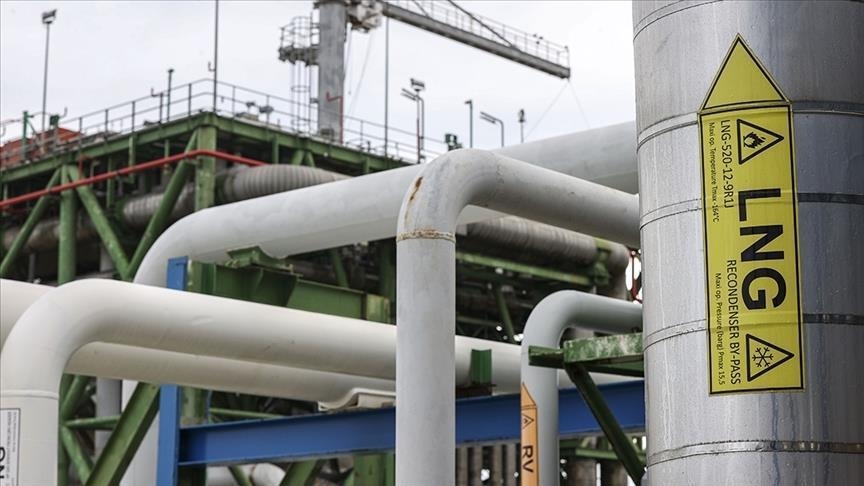

By Anadolu Agency
ANKARA
Some Asian countries that are unable to afford LNG face the risk of power curtailment and blackouts this winter, according to Kaushal Ramesh, a senior analyst at energy consultancy, Rystad.
Ramesh told Anadolu Agency that the high gas price environment this summer has meant that despite unmet demand from the power sector amid the ongoing heatwave, price-sensitive regions such as South Asia have had to ‘lose’ LNG volumes to Europe.
With the current bullish sentiment on Europe’s wholesale gas price market trading on the Dutch TTF, he expects Asian spot prices will remain elevated to attract marginal US cargoes.
“That tells us that countries that are unable to afford prices in the vicinity of $50/MMBtu (Metric Million British thermal unit) – likely parts of South and Southeast Asia – are not able to activate alternative sources such as fuel oil or coal for whatever reason – are at risk of facing a ‘dark winter’,” Ramesh said.
He added that “OECD countries within Asia, such as Japan and South Korea, can compete with North West Europe, so given the forewarnings of power market tightness in Japan this winter, chances are there will be some competition with Asian and European countries.”
What happens in Asian countries?
Pakistan
Ramesh noted that parts of Pakistan have been facing 12-hour blackouts since June, and have re-allocated gas from fertilizer plants to power plants, but this is setting the stage for a food crisis in one year.
“Coupled with the country’s dwindling foreign exchange reserves, the energy shortage may put Pakistan on the path of a vicious economic spiral that may take years to undo,” he said.
Bangladesh
Bangladesh similarly experienced a nationwide power outage in early July, limiting the working hours of commercial buildings such as shops and shopping malls. Gas is also unavailable to the transport sector at compressed natural gas (CNG) filling stations for six hours a day.
India
The state-owned petroleum company, GAIL, has sounded the alarm after Gazprom marketing and trading, now a unit of Gazprom Germania began to cut contractual supplies to India.
“Further supplies under the 2.5 million tonnes per annum (Mtpa) contract are now uncertain with GAIL cutting output at certain industrial facilities. The state-owned petrochemical sector is among the less price sensitive buyers in India, suggesting they may be forced to buy from the spot market to cover this contract if other commercial arrangements prove insufficient,” he explained.
China
China has not been immune either as in July, its manufacturing survey indicated that activity has continued to contract, with the market now expecting a slower recovery from Covid-19 lockdowns than before, which could continue into 2023.
He noted that China’s LNG imports are down 30% year on year for the May to July period and will likely total just 67 million tonnes per year for 2022, returning the ‘largest LNG importer’ title to Japan.
According to Ramesh, most Northeast Asian buyers have been observing Europe’s situation keenly and so have been preparing for winter by purchasing cargoes on a short-term basis.
Thailand
Weak domestic gas production in Thailand particularly reduced production from the Erawan gas field has ensured an expansion in LNG import capacity.
This has been seen with a boost in imports in the Nong Fab terminal from a commissioning cargo in June.
“This will add 2.5 Mtpa of import capacity before the end of the year, with a further 5 Mtpa expansion in the works,” Ramesh said.
Thai state-owned SET-listed oil and gas company, PTT, surprised the market with sustained spot buying throughout the summer, having purchased several cargoes in the vicinity of $45/MMBtu.
Korea
Korea is expected to build LNG stocks to 90% full by November, which should suffice for even a severe winter.
Japan
Ramesh expects that Japan, which had predicted early in the year that the power balance in the winter would be very tight, has likely taken precautionary measures accordingly.
“So while we may not see a price surge on account of sudden buying in Asia, we are still likely to see elevated prices – perhaps continuously in excess of $40/MMBtu – because certain Asian buyers in Japan and South Korea can indeed compete with Europe,” he said.
We use cookies on our website to give you a better experience, improve performance, and for analytics. For more information, please see our Cookie Policy By clicking “Accept” you agree to our use of cookies.
Read More